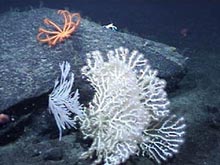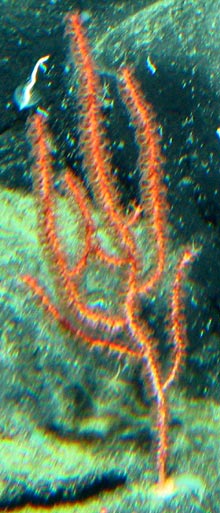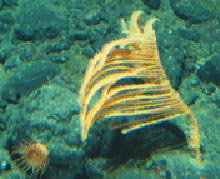
Deep-sea Primnoid and Paragorgid corals at 2,766 m on Derickson Seamount. Note the brisingid sea star on the rock (upper left corner) and a galatheid crab on top. Click image for larger view.
Deep-sea Coral Distribution on the Northern Seamount Chain
Amy R. Baco-Taylor, PhD
Woods Hole Oceanographic Institution
There are thousands of seamounts in the world’s oceans. Of those, 190 are in the Gulf of Alaska. Three seamount chains in the gulf run parallel to each other. In 2002 we explored five seamounts on the central chain. This year, during the 2004 Gulf of Alaska expedition, we will be exploring the northern chain of seamounts and studying the fauna we find there.
Seamount fauna are often quite isolated from other deep-sea fauna, potentially leading to their reproductive isolation and eventually to the formation of new species. Not surprisingly, a large percentage of the fauna that have been studied on seamounts are endemic (i.e., found only on that particular seamount). The dominant hard-bottom fauna of seamounts are the deep-sea corals, primarily gorgonian octocorals.
Scientists need to characterize the fauna living on these seamounts and to gain a better understanding of the biology of these exciting habitats. The information is important. Unfortunately, in many parts of the Pacific Ocean, destructive trawl fishing for orange roughy and other deep-sea fishes scrapes the seamounts clean of all fauna.
One of the goals of our studies is to understand how corals are distributed on the seamounts. To do this, we will conduct baseline surveys of deep-sea corals at each seamount. Specifically, we will conduct horizontal transects at the same three depths on each seamount to determine if similar species are found across the seamount chain. We will also conduct surveys along the full depth range of each seamount to get some idea of the depth ranges for each species. During these surveys, we will collect samples of the dominant coral species. The samples will be used for taxonomic identification, with the help of the Smithsonian Institution.

A specimen of Swifta simplex coral from the family Elisellid was collected on our first dive on Denson Seamount. Click image for larger view.

A close up of Swifta simplex coral from the family Elisellid collected by the DSV Alvin. Click image for a larger view.

We collected this Antipatharian (black coral) on our first DSV Alvin dive on Denson Seamount.
Deep-sea gorgonian corals also provide habitat for many other creatures. The corals add habitat complexity, altering the sea floor by adding a large structure for other organisms to climb up and to reach higher into the water column. Many of these organisms are also suspension feeders, like the corals; the higher up they get into the water column, the more food they will find. We find many invertebrates -- including brittle stars, basket stars, crinoids (sea lilies), polychaetes, pinch bugs, and sponges -- living on coral trees. Thus, another goal of our surveys will be to document the associations between the corals and all these critters.
(top)
























